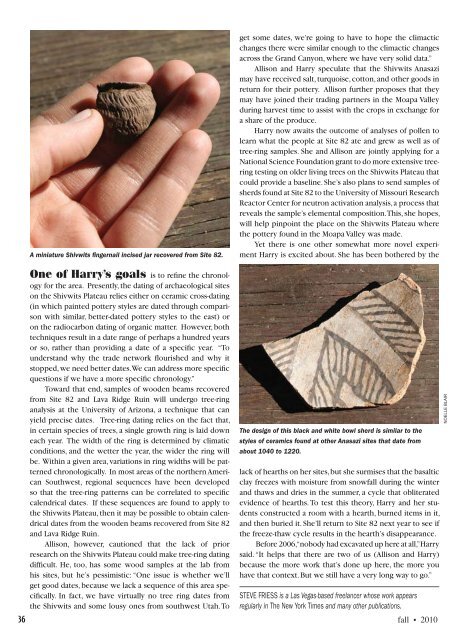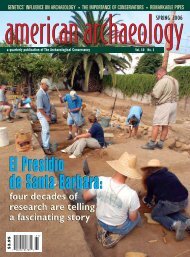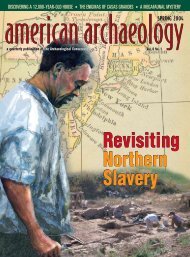Clovis Comet Debate - The Archaeological Conservancy
Clovis Comet Debate - The Archaeological Conservancy
Clovis Comet Debate - The Archaeological Conservancy
You also want an ePaper? Increase the reach of your titles
YUMPU automatically turns print PDFs into web optimized ePapers that Google loves.
A miniature Shivwits fingernail incised jar recovered from Site 82.<br />
One of Harry’s goals is to refine the chronology<br />
for the area. Presently, the dating of archaeological sites<br />
on the Shivwits Plateau relies either on ceramic cross-dating<br />
(in which painted pottery styles are dated through comparison<br />
with similar, better-dated pottery styles to the east) or<br />
on the radiocarbon dating of organic matter. However, both<br />
techniques result in a date range of perhaps a hundred years<br />
or so, rather than providing a date of a specific year. “To<br />
understand why the trade network flourished and why it<br />
stopped, we need better dates. We can address more specific<br />
questions if we have a more specific chronology.”<br />
Toward that end, samples of wooden beams recovered<br />
from Site 82 and Lava Ridge Ruin will undergo tree-ring<br />
analysis at the University of Arizona, a technique that can<br />
yield precise dates. Tree-ring dating relies on the fact that,<br />
in certain species of trees, a single growth ring is laid down<br />
each year. <strong>The</strong> width of the ring is determined by climatic<br />
conditions, and the wetter the year, the wider the ring will<br />
be. Within a given area, variations in ring widths will be patterned<br />
chronologically. In most areas of the northern American<br />
Southwest, regional sequences have been developed<br />
so that the tree-ring patterns can be correlated to specific<br />
calendrical dates. If these sequences are found to apply to<br />
the Shivwits Plateau, then it may be possible to obtain calendrical<br />
dates from the wooden beams recovered from Site 82<br />
and Lava Ridge Ruin.<br />
Allison, however, cautioned that the lack of prior<br />
research on the Shivwits Plateau could make tree-ring dating<br />
difficult. He, too, has some wood samples at the lab from<br />
his sites, but he’s pessimistic: “One issue is whether we’ll<br />
get good dates, because we lack a sequence of this area specifically.<br />
In fact, we have virtually no tree ring dates from<br />
the Shivwits and some lousy ones from southwest Utah. To<br />
get some dates, we’re going to have to hope the climactic<br />
changes there were similar enough to the climactic changes<br />
across the Grand Canyon, where we have very solid data.”<br />
Allison and Harry speculate that the Shivwits Anasazi<br />
may have received salt, turquoise, cotton, and other goods in<br />
return for their pottery. Allison further proposes that they<br />
may have joined their trading partners in the Moapa Valley<br />
during harvest time to assist with the crops in exchange for<br />
a share of the produce.<br />
Harry now awaits the outcome of analyses of pollen to<br />
learn what the people at Site 82 ate and grew as well as of<br />
tree-ring samples. She and Allison are jointly applying for a<br />
National Science Foundation grant to do more extensive treering<br />
testing on older living trees on the Shivwits Plateau that<br />
could provide a baseline. She’s also plans to send samples of<br />
sherds found at Site 82 to the University of Missouri Research<br />
Reactor Center for neutron activation analysis, a process that<br />
reveals the sample’s elemental composition. This, she hopes,<br />
will help pinpoint the place on the Shivwits Plateau where<br />
the pottery found in the Moapa Valley was made.<br />
Yet there is one other somewhat more novel experiment<br />
Harry is excited about. She has been bothered by the<br />
<strong>The</strong> design of this black and white bowl sherd is similar to the<br />
styles of ceramics found at other Anasazi sites that date from<br />
about 1040 to 1220.<br />
lack of hearths on her sites, but she surmises that the basaltic<br />
clay freezes with moisture from snowfall during the winter<br />
and thaws and dries in the summer, a cycle that obliterated<br />
evidence of hearths. To test this theory, Harry and her students<br />
constructed a room with a hearth, burned items in it,<br />
and then buried it. She’ll return to Site 82 next year to see if<br />
the freeze-thaw cycle results in the hearth’s disappearance.<br />
Before 2006, “nobody had excavated up here at all,” Harry<br />
said. “It helps that there are two of us (Allison and Harry)<br />
because the more work that’s done up here, the more you<br />
have that context. But we still have a very long way to go.”<br />
STEVE FRIESS is a Las Vegas-based freelancer whose work appears<br />
regularly in <strong>The</strong> New York Times and many other publications.<br />
36 fall • 2010<br />
noelle blair




